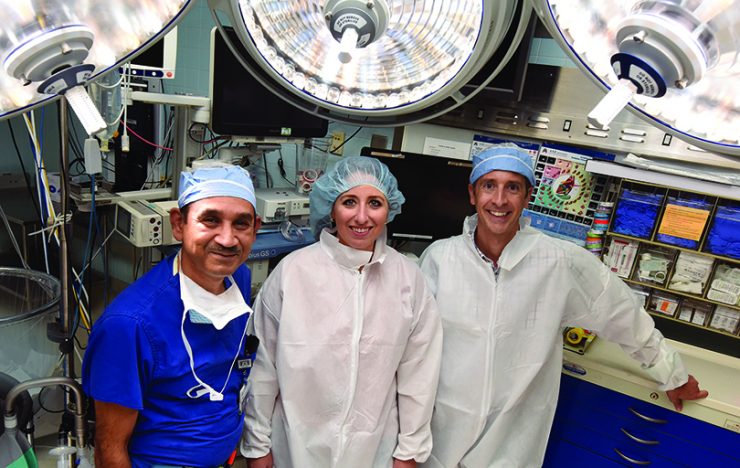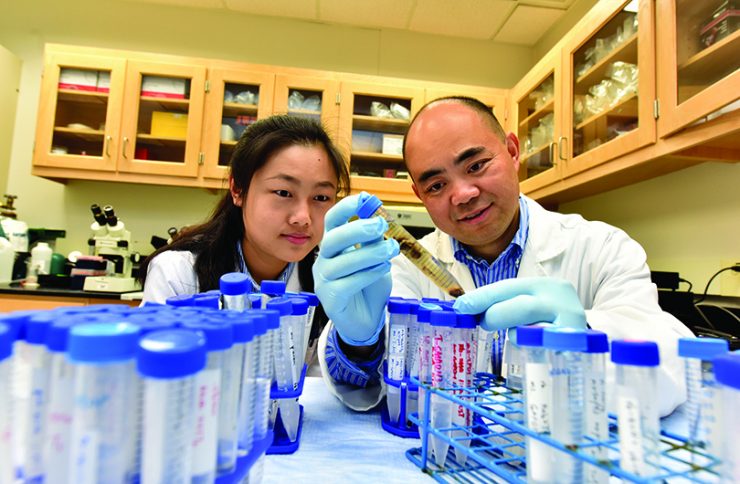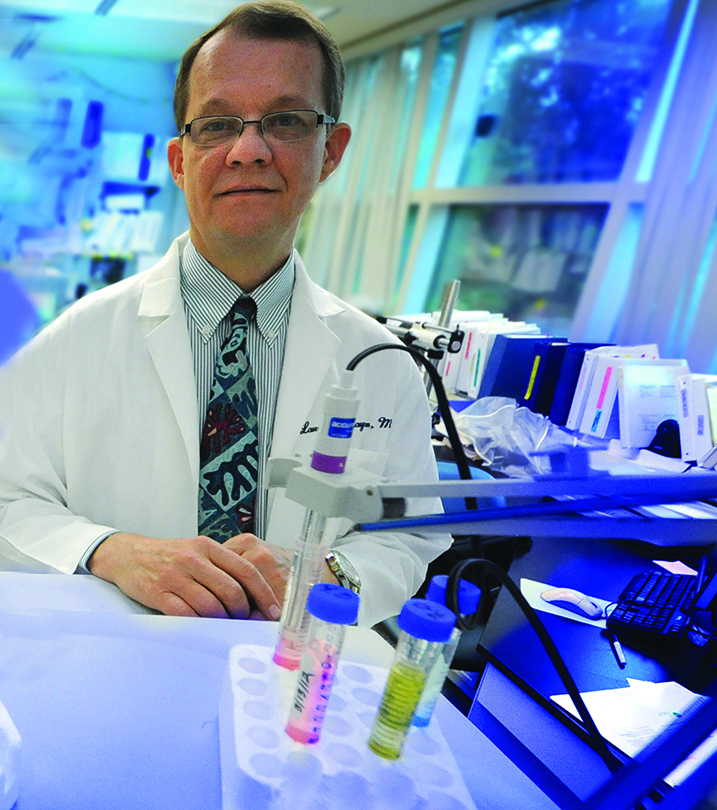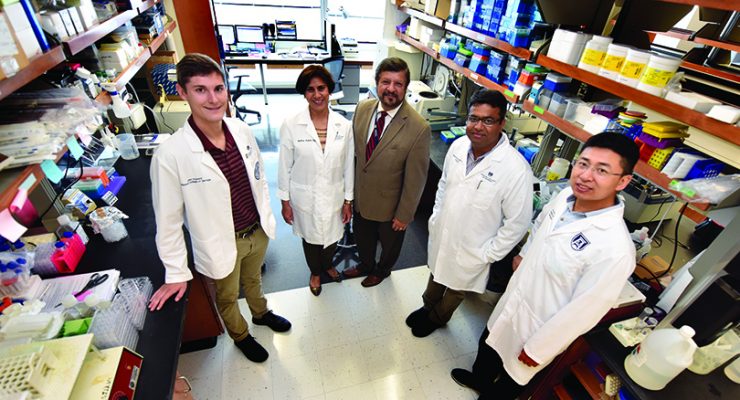American Society for Reproductive Medicine’s Distinguished Researcher Award
Dr. Lawrence C. Layman, chief of the Section of Reproductive Endocrinology, Infertility and Genetics in the Department of Obstetrics and Gynecology, is the 2019 recipient of the American Society for Reproductive Medicine’s Distinguished Researcher Award.
Layman, Robert B. Greenblatt, MD, Distinguished Chair in Endocrinology and co-director of the MD/PhD Program of MCG and the University System of Georgia, was selected for his basic and clinical research efforts to significantly advance the understanding of genes important in the process of reproductive development, sexual differentiation, puberty as well as the function of other organs. He was honored at the society’s recent Scientific Congress in Philadelphia.
Layman’s clinical expertise includes delayed puberty, infertility, recurrent pregnancy loss and menopause. A prolific physician-scientist, his current studies include the National Institutes of Health-funded genetic analysis of hundreds of patients with MRKH Syndrome, where the vagina and uterus do not develop. He is co-principal investigator on a National Heart, Lung and Blood Institute grant looking at the impact of estrogen on vascular health in diabetes.
He is the American Society for Reproductive Medicine’s liaison to the American College of Obstetrics and Gynecology’s Committee on Genetics, and a member of the society’s Research Task Force and Research Steering Committee. He served as a society board member from Oct. 2017-Oct. 2018.
Third-Year Medical Student awarded prestigious scholarship
Bria Peacock, a third-year medical student, has received an Association of American Medical Colleges 2019 Herbert W. Nickens Medical Student Scholarship.
The $5,000 scholarship, one of only five awarded each year, goes to rising third-year medical students who demonstrate leadership in eliminating inequities in medical education and health care and in addressing the needs of minorities.
Peacock, who plans to pursue a career in obstetrics and gynecology, is the founder of SIHLE (Sisters Informing Healing Living and Empowering) Augusta, a program she started as a first-year student that works to address the sexually transmitted disease, HIV, and teenage pregnancy rates through discussion style sessions for girls ages 14-18 and for teen mothers. The program, includes a Centers for Disease Control and Prevention-based curriculum and seeks to empower black girls through safer sex education including abstinence, building self-esteem and confidence, assertiveness in communication skills and assessing values and goal setting. “The goal is for the girls to know self-love, self-respect, self-care and self-responsibility,” Peacock says. She has graduated three classes of teen moms and teen girls from the program and her work has been recognized and honored by the American College of Obstetricians and Gynecologists District IV Medical Student Group.
Fighting the resistance
A big way chemotherapy works is by prompting cancer cells to commit suicide, and scientists have found a pathway the most common lung cancer walks to avoid death.
Scientists at MCG and the Georgia Cancer Center have found a first step appears to be lung cancer cells expressing high levels of the molecule TIMP-1, classically considered a tumor inhibitor but at high levels already associated with a poor prognosis for patients.
TIMP-1 then turns up expression of the immune system modulator IL-6, which is already associated with resistance to cancer chemotherapy. Levels of both increase even further in the face of chemotherapy treatment, a mainstay for treatment of the common, non-small cell lung cancer they studied.
Chemotherapy resistance is a big problem in this lung cancer type, particularly when the cancer recurs at which point it’s also more aggressive, says Dr. Mumtaz Rojiani, cancer biologist.
To see just how TIMP-1 contributes, Rojiani and her colleagues first explored whether TIMP-1 enabled cancer cells’ uncanny ability to essentially spit out a chemotherapy drug. While they didn’t see evidence of that phenomenon in their studies in human lung cancer cells, they did see an increased level of IL-6.
IL-6 is a sugar-coated protein that can turn inflammation both up and down and actually has been shown to regulate TIMP-1 —rather than vice versa — in some cancers.
But in lung cancer, at least, the scientists saw TIMP-1 take the lead in avoiding cell suicide, a natural process that should happen when cells become dysfunctional.
Innate ability to fight depression, stress
Chronic stress can inflame our brain, destroy the connections between our neurons and result in depression, scientists say.
Now they are working to better understand how the destructive cycle happens and how best to intervene.
Even powerful, prescription anti-inflammatory drugs that should help break the connectivity between chronic stress and inflammation don’t help many patients with depression, says Dr. Anilkumar Pillai, neuroscientist in the Department of Psychiatry and Health Behavior.
Two new grants totaling about $2.4 million from the National Institute of Mental Health are helping Pillai further explore his increasing evidence that the problem may start with the impact stress has on our bodies and the body’s fundamental, frontline and nonspecific immune response called innate immunity.
The complement system, named because it was first found to help the immune system fight invaders, is part of this innate immune response, and Pillai has found elevated levels of C3 — which he calls the hub of all complement activation pathways — in both the brains of people with depression and animal models.
C3 is known to play a key role in inflammation in the brain, and microglia, the resident immune cells in the brain, are known to use C3 during brain development to eliminate synapses.
“We expect that chronic stress increases C3,” Pillai says as he continues to put the complex puzzle together. Now he and his colleagues want to know where the high C3 is coming from, and whether it’s immune cells called monocytes, circulating in the body in response to stress, or the microglia. It may turn out that microglia are the direct sources but changes chronic stress makes to the body are the instigators in this vicious, destructive circle.
Under Pressure
Whether elevated blood pressure early in life translates to increased risk of dementia is a question scientists are working to answer.
There are many dementia risk factors, most of which also are known risks for cardiovascular disease, including high cholesterol and blood pressure, stiffening arteries, obesity and simply getting older.
Dr. Shaoyong Su, genetic epidemiologist at the Georgia Prevention Institute, and his colleagues appear to be the first to specifically explore whether a higher or more rapidly increasing blood pressure in childhood helps set the stage as higher pressures lead to vascular damage resulting in less blood flow and likely, eventual brain cell damage in some areas.
They are looking again at 600 people, now an average of 40 years old, who have had comprehensive data collected up to 16 times over 23 years, including measures like ambulatory blood pressure, arterial stiffness and other measures of chronic stress and lifestyle. Like the general population, about one-third of the group are now hypertensive.
Investigators are doing painless, sophisticated brain imaging to look at relevant factors like cerebral blood flow as well as cognitive testing as a check of their brain health. They want to answer questions like whether the arterial stiffness and even atherosclerosis they have already identified in the vasculature of some of these still-young individuals are associated with unhealthy structural and functional changes in the brain as they now reach into midlife.
The female factor
In the face of obesity, the sex hormone progesterone that helps females get and stay pregnant appears to also put them at increased, early risk for cardiovascular disease, investigators report.
Premenopausal women are considered protected from cardiovascular disease, but evidence indicates obesity can negate those benefits, and in fact put them at even higher risk than men, but just how remains an unfolding mystery.
As they walk down the path to how their protection is lost, investigators have now documented high levels of a receptor for the hormone aldosterone, which can damage the vasculature, in the endothelial cells that line blood vessels, and that progesterone enables the high levels of receptor expression they found, says Dr. Eric Belin de Chantemele, physiologist in the Vascular Biology Center and Department of Medicine.
The latest findings, published in the journal Hypertension, were consistent in both animal models and, for the first time, in human blood vessels as well.
Corresponding author Belin de Chantemele and his colleagues reasoned and have now confirmed that females just have higher expression of these mineralocorticoid receptors on endothelial cells.
Females also have naturally higher levels of the hormone aldosterone, and in the face of obesity, produce even more of the hormone, which is bad for blood vessels at these now very high levels.
Rest of the story
Insomnia is a driver of suicide, and people with severe insomnia may safely benefit from taking a sedative to help address their sleep problems as it reduces their suicidal thoughts, investigators report.
More than 30 studies have linked insomnia to suicidal thoughts or actions, however suicide risk and prevention are largely overlooked in the treatment of insomnia, says Dr. Vaughn McCall, chair of the Department of Psychiatry and Health Behavior and an expert in the trifecta of insomnia, depression and suicide.
He is hoping the REST-IT — Reducing Suicidal Ideation Through Insomnia Treatment — study, the first clinical trial looking at whether targeted insomnia treatment reduces suicide risk, will help change that. The study at MCG, Duke University and the University of Wisconsin included 103 participants ages 18 to 65 with major depressive disorder, insomnia and suicidal thoughts. Thirty percent had a prior suicide attempt.
All participants took an antidepressant for the eight-week trial and half also took the sedative-hypnotic zolpidem at bedtime.
Those taking the sleep aid showed both immediate and longer-term improvement in their insomnia severity. While both groups reported significant improvement in feelings about hopelessness, quality of life, nightmares and dysfunctional beliefs about sleep, as well as related insomnia and suicidality, the sleep aid was most effective in reducing suicidal thoughts in those with the most severe insomnia.
The heart of the problem
Heart muscle can continue to die even after restoring blood following a heart attack, and scientists have new evidence that one way to help it live is by boosting levels of a tiny RNA that helped the heart form.
In their mouse model of this ischemia/reperfusion injury of the heart, they’ve found they can reduce heart muscle death 40% by giving a manmade version of the microRNA miR322, they report in the Journal of Molecular and Cellular Cardiology.
MiR322 is known to coax stem cells to make heart cells during development but is typically found at a lower, more basal level and with an unclear purpose in the adult heart, says Dr. Yaoliang Tang, cardiovascular researcher in the Vascular Biology Center and Department of Medicine.
Tang and his team were looking for better ways to protect the heart from additional damage, doing high throughput analysis of microRNAs, which help regulate gene function, and miR322 was the first standout as the most dramatically reduced after blood flow to the heart was restored.
So Tang’s team began looking for the source of miR322 in adult hearts — which turned out to be the endothelial cells that line the blood vessels — and in the process they also found miR322’s target.
They first caused an occlusion in the left coronary artery of mice for about 45 minutes, then enabled reperfusion to reflect what happens when a human has a heart attack, then gets treatment.
During the period of ischemia —when the heart attack happens — they saw seriously reduced miR322 levels, which recovered after blood and oxygen were restored but dropped dramatically again one day later, the lowest point was seven days later.
When they increased miR322 by giving what scientists call its mimic, they saw levels of the endogenous heart cell protector Notch 1 significantly increase while levels of cell suicide promoter FBXW7 significantly decreased, and heart damage reduced.
When they gave both miR322 mimic and FBXW7 plasmid — a plasmid is a small DNA molecule, which can be used to increase expression of a gene — Notch 1 levels instead decreased and the heart benefit was lost, implicating FBXW7 as a direct target of miR322.















